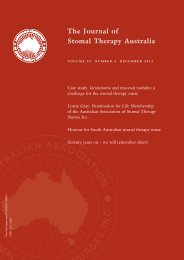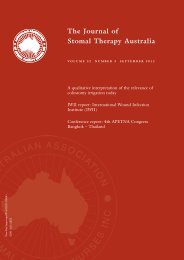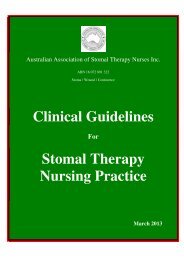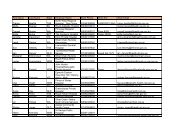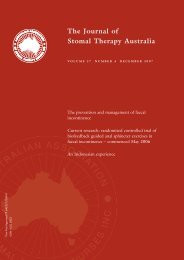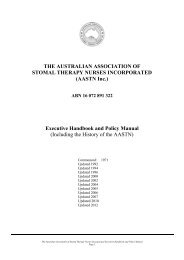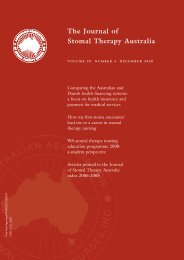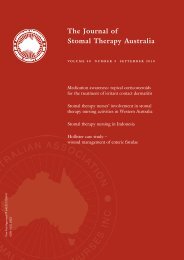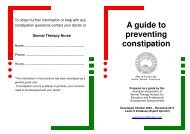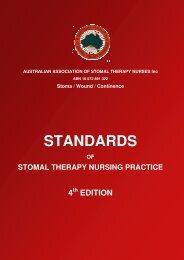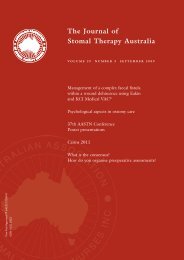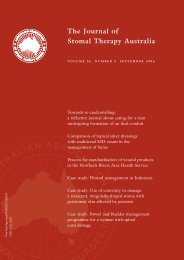JSTA December 2010 - Australian Association of Stomal Therapy ...
JSTA December 2010 - Australian Association of Stomal Therapy ...
JSTA December 2010 - Australian Association of Stomal Therapy ...
You also want an ePaper? Increase the reach of your titles
YUMPU automatically turns print PDFs into web optimized ePapers that Google loves.
causes a decrease in gastrointestinal motility 19 , the desired effect<br />
in this case. This was explained to the ward nurses so that they<br />
understood the aim <strong>of</strong> treatment (14.1). When the desired result<br />
was apparent, the Loperamide was ceased because the Codeine<br />
produced a more satisfactory outcome (1.7). The faecal output<br />
was thick enough to facilitate management <strong>of</strong> the colostomy<br />
without leakage and the stoma continued to function. When she<br />
was ready for discharge, the stents were still in place. I contacted<br />
the urologist to inform him <strong>of</strong> the pending discharge (5.7)<br />
and was asked to remove the stents 17 after giving intravenous<br />
antibiotic cover. I worked with the ward nurse to ensure the<br />
antibiotics were given (5.5). I removed the stents according to<br />
instructions given on previous occasions (6.3). A graduate nurse<br />
who was working in the area asked to observe the procedure.<br />
I explained to her the principles as I worked (13.2). I also<br />
explained to the patient that she should observe for continued<br />
drainage <strong>of</strong> urine from the urostomy to ensure the ureters<br />
remained functional and to report fever, back pain, feeling<br />
unwell or blood in the urine (4.3). I documented the orders and<br />
signed for removal <strong>of</strong> the stents in the patient’s chart (3.1).<br />
During my development from clinical colorectal nurse to student<br />
STN, I have attended conferences, workshops and product<br />
launches (6.1, 6.2, 6.3). A very pr<strong>of</strong>essional case study was<br />
presented by a fellow student at one meeting, which impressed<br />
me with the quality and depth <strong>of</strong> knowledge displayed (10.5).<br />
I compared my own knowledge and realised the need to<br />
continually strive for improvement (2.2). However, the best<br />
learning experiences have been when I have been asked to<br />
provide education for others. I have given a presentation titled<br />
Stoma Products. Diverse Uses at a wound management course<br />
conducted yearly at our hospital by my mentor (STN ) (12.1).<br />
The basics had been formulated by another STN with whom I<br />
have worked. I expanded on this by adding some information<br />
and photographs <strong>of</strong> my own. I acknowledged her contribution<br />
(11.1) to the audience, which consisted <strong>of</strong> RNs and enrolled<br />
nurses (ENs) from our organisation and others, as well as the<br />
community, and sales representatives (13.1). This activity helped<br />
me gain confidence in my own knowledge and ability. I have<br />
recently given a presentation at a vascular workshop consisting<br />
<strong>of</strong> 40 delegates. My contribution was a 40-minute lecture on<br />
leg ulcers (13.2). This was an ideal learning experience for me,<br />
as I undertook extensive literature searches and compared our<br />
treatments with those described in the literature to ensure that<br />
the information I was giving was factual and relevant (10.2).<br />
I have also given an informal presentation relating to stoma<br />
care and the expectations placed on the ward EN to a group <strong>of</strong><br />
student ENs on placement in my workplace (14.2). My aim is to<br />
always be sure <strong>of</strong> the facts so that teaching others comes more<br />
easily.<br />
An issue <strong>of</strong> importance to me has been my integration into<br />
the pr<strong>of</strong>ession <strong>of</strong> STNs. A continuous process <strong>of</strong> development,<br />
internal discussion and external feedback shapes a pr<strong>of</strong>ession’s<br />
current identity 20 . This is evident in every meeting <strong>of</strong> these<br />
nurses. Mantzoukas and Jasper 21 believe that there still exists<br />
an unequal relationship between RNs and doctors. However,<br />
every day I witness the respect in which the STN is held<br />
by the consultants with whom we work. I feel proud to be<br />
accepted into this group and am committed to upholding this<br />
image. Hornby and Atkins 20 state that just as an individual<br />
needs to have a satisfying self-image, a pr<strong>of</strong>ession needs to<br />
establish, promote and protect a strong, cohesive and satisfying<br />
pr<strong>of</strong>essional image with which its practitioners can identify. The<br />
Standards <strong>of</strong> <strong>Stomal</strong> <strong>Therapy</strong> Nursing 1 include in the philosophy<br />
“a responsibility to share their knowledge and skills with others,<br />
including those in the health pr<strong>of</strong>ession”. I have experienced this<br />
firsthand. Ideas are regularly shared and support <strong>of</strong>fered.<br />
The area <strong>of</strong> research is a weakness in my practice which I intend<br />
to change. I have been involved in only minor areas <strong>of</strong> research,<br />
such as evaluation <strong>of</strong> products. I have helped collect data<br />
for evaluation <strong>of</strong> intravenous site dressings and new ostomy<br />
products (9.2). I have participated in the use and evaluation <strong>of</strong><br />
alternative negative pressure wound devices. I realise that when<br />
qualified, as a member <strong>of</strong> the AASTN it is imperative that I<br />
become active in the association and participate in maintaining<br />
the high standards already set. This will necessitate an ongoing<br />
commitment to education. Newhouse, Dearbolt, Poe, Pugh<br />
and White 22 state that the move towards informed pr<strong>of</strong>essional<br />
practice requires evaluation <strong>of</strong> existing practice, synthesis <strong>of</strong><br />
current available evidence, and incorporating the best new<br />
evidence into practice.<br />
As a clinical nurse working in the colorectal ward at my<br />
organisation, I was responsible for producing the clinical<br />
pathways for general and colorectal surgery (12.2). It was also<br />
my responsibility to teach staff how to record variances and to<br />
audit these variances (9.2) for quality improvement 23 . Currently<br />
at my workplace the STN is involved in product evaluation,<br />
pressure area prevention and monitoring <strong>of</strong> all reports <strong>of</strong><br />
skin tears to ensure protocols are followed and patient safety<br />
is maintained (9.6). At this stage <strong>of</strong> my development I am<br />
participating in some <strong>of</strong> these areas but have not taken part in<br />
the product evaluation group.<br />
Assessing my development during this course, I believe I<br />
now have a better grasp <strong>of</strong> the theory behind the day-to-day<br />
practice. Although I have taken advantage <strong>of</strong> the available<br />
journals and texts, particularly those <strong>of</strong> Blackley and Carville,<br />
literature search for assignments has taught me to look further<br />
afield also. Bawden and McKinnon 24 imply that the dynamic<br />
nature <strong>of</strong> learning means that it is never really completed. I<br />
do not consider myself an expert STN. I believe that I am at<br />
the pr<strong>of</strong>icient stage as described by Benner 25 . I have had the<br />
experience over time but must still at times resort to analysing a<br />
situation before deciding on a correct course <strong>of</strong> action.<br />
refereNceS<br />
1. <strong>Australian</strong> Nursing Federation. Competency standards for nurses in<br />
general practice. Advanced registered nurses. Melbourne, Vic: ANF,<br />
2005, pp. 2–7.<br />
2. Oxford Dictionary. Accessed 4 April 2008, askoxford.com/results/<br />
?view=searchresults&freesearch=reflection&branch=&textsearchtyp<br />
e=exactuseaskoxford.com<br />
3. Ghebrehiwet T. Doing what’s right: The ethics <strong>of</strong> nursing. Helping<br />
nurses make ethical decisions. Reflection on nursing leadership.<br />
Third quarter (Feature six), 2005. Accessed 28 February 2006, www.<br />
nursingsociety.org/RNL/RNL3rdQtr.pdf<br />
Journal <strong>of</strong> <strong>Stomal</strong> therapy australia – Volume 30 Number 4 25



